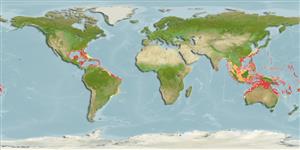Common names from other countries
Classification / Names / Names
Populärnamn | synonymer | Catalog of Fishes (gen., sp.) | ITIS | CoL | WoRMS
Environment: milieu / climate zone / depth range / distribution range
Ekologi
; brackvatten; djupintervall 1 - 91 m (Ref. 108813). Tropical
Indo-Pacific and Western Atlantic: Caribbean wide.
Length at first maturity / Size / Vikt / Age
Maturity: Lm ? range ? - ? cm Max length : 60.0 cm TL hane/ej könsbestämd; (Ref. 415)
Sprawling ramose branches, with spiky surface up to 60 cm long; 1 - 5 cm wide. Black with green patches internally and externally. Oscula 0.1 - 0.3 cm in diameter, on side of branches (Ref. 415). Smaller specimens grows as lobes, runners, massive or encrusting. Surface: covered with conules; mostly or entirely smooth for small specimens. Sometimes greenish-yellow. Tough consistency; resilient and barely compressible. Exudate is dark purplish when squeezed. Oscules are scattered or in a row, slightly raised on small lobes and surrounded by a thin collar (Ref. 85482).
Reef; mangrove; seagrass environments (Ref. 415). On hard substrates, often hosting the zoanthid Parazoanthus swiftii (Ref. 85482). Commensal with amphipods (Ref. 82302).
Life cycle and mating behavior
Könsmognad | Reproduktion | Lek | Ägg | Fecundity | Larver
Members of the class Demospongiae are hermaphroditic. Life cycle: The zygote develops into parenchymella larva (free-swimming) before settling down on a substrate where it grows into a young sponge.
Collin, R., M.C. Díaz, J. Norenburg, R.M. Rocha, J.A. Sánchez, M. Schulze, A. Schwartz and A. Valdés. 2005. (Ref. 415)
IUCN Red List Status (Ref. 130435)
CITES status (Ref. 108899)
Not Evaluated
Not Evaluated
Threat to humans
Harmless
Human uses
| FishSource |
Verktyg
Ytterligare information
Age/SizeTillväxtLength-weightLength-lengthMorfologiLarverAbundans
Internet-källor
Estimates based on models
Preferred temperature
(Ref.
115969): 23.9 - 28.9, mean 27.5 (based on 1216 cells).
Vulnerability
Moderate vulnerability (44 of 100).
Price category
Unknown.
